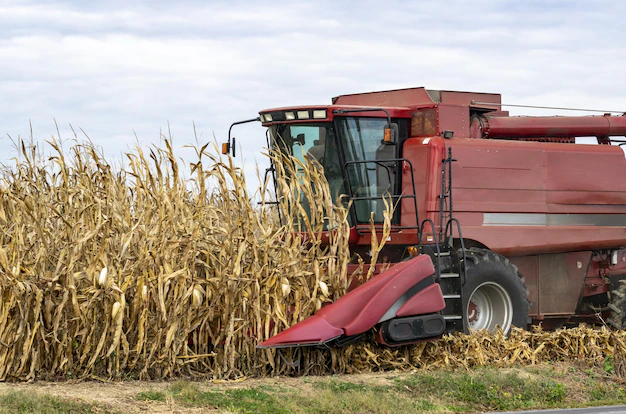Harvesters and threshers play crucial roles in the process of crop harvesting, making it more efficient and less labor-intensive. Let’s look at their individual roles:
- Harvesters: Harvesters are specialized machines designed to cut and gather crops efficiently. They are commonly used for grain crops such as wheat, barley, corn, and soybeans. The primary function of a harvester is to remove the grain heads or seed heads from the plant stalks. The machine accomplishes this by using a cutting mechanism, usually a rotating reel or a reciprocating knife, to sever the stalks at the base. The harvested crop is then conveyed into a storage bin or directly into a trailer for transport.
Modern harvesters often come equipped with advanced technologies, such as adjustable cutting heights, automated control systems, and onboard computers. These features allow operators to optimize the harvesting process by adjusting cutting parameters based on crop conditions, enhancing productivity, and minimizing losses.
- Threshers: Threshers are machines used to separate grain crops from their stalks or husks after harvesting. Traditionally, this process was done manually by beating the harvested crop against a hard surface or using animals to trample over it. However, mechanized threshers have largely replaced these labor-intensive methods.
A thresher typically consists of a rotating drum or a series of beaters, which rub against the crop to separate the grain from the stalks or husks. The separated grain is collected, while the remaining straw or chaff is expelled as waste.
Threshers are highly efficient in separating grain from the harvested crop, significantly reducing the time and effort required for manual threshing. They are especially valuable for large-scale farming operations where time and labor savings are critical.
By employing harvesters and threshers, farmers can achieve several advantages:
- Increased efficiency: Mechanized harvesting reduces the time and labor required for crop harvesting, enabling farmers to cover larger areas within shorter periods.
- Reduced labor dependency: Harvesters and threshers reduce the need for manual labor during the harvesting process, leading to cost savings and alleviating labor shortages.
- Improved crop quality: These machines are designed to handle crops gently, minimizing damage and preserving grain quality during the harvesting and threshing operations.
- Minimized losses: Harvesters and threshers are equipped with features to reduce crop losses due to shattering, lodging, or weather-related factors. They help ensure a higher percentage of the crop is successfully harvested and processed.
Harvesters and threshers are essential agricultural machinery that streamline the crop harvesting process. They enhance efficiency, reduce labor requirements, improve crop quality, and minimize losses, ultimately contributing to increased productivity and profitability for farmers.
Join 'Farmers Mag' WhatsApp Channel
Get the latest Farming news and tips delivered straight to your WhatsApp
CLICK HERE TO JOIN






